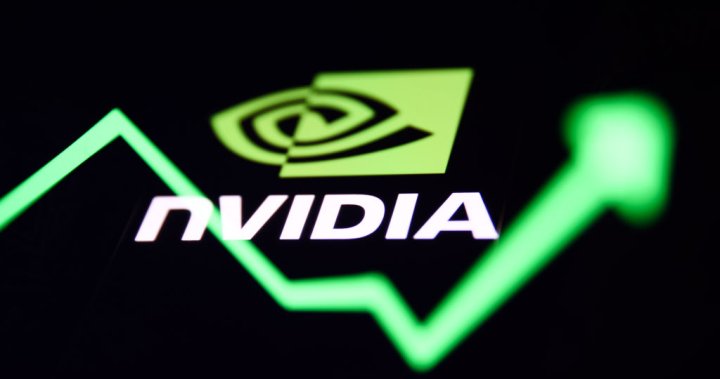
The blockbuster growth of stocks such as chipmaker Nvidia in recent weeks shows investors are excited about the potential of artificial intelligence, some experts say.
There could be money to be made in artificial intelligence, according to wealth managers who spoke to Global News, but they say there are some risks tied to the sector that might have you thinking twice about going all in on AI.
Nvidia made headlines this past week as the California-based semiconductor company surpassed a valuation of US$1 trillion, joining an exclusive club with the likes of Apple and Microsoft who’ve crested that bar. The company’s stock on the tech-heavy NASDAQ was up roughly 175 per cent on the year as of Friday afternoon.
Allan Small, a senior investment advisor who runs his own firm with iA Private Wealth, says Nvidia’s rapid rise comes because of its commanding market position as one of the few companies building the chips capable of powering the artificial intelligence applications that have dominated headlines in recent months.

The advanced capabilities of ChatGPT, OpenAI’s chatbot that can write high schoolers’ English essays, recommend new recipes and even pass the bar exam, has some futurists imagining a world where AI revolutionizes business and everyday life, he explains.
Other chipmakers such as Advanced Micro Devices have seen share prices surges this year for a similar reason to Nvidia’s rise, Small tells Global News. Other big names in tech such as Google parent Alphabet and Microsoft are also seeing boosts, he says, as they talk up their own AI plans and look to compete with OpenAI.
“I think with all the talk about ChatGPT over the last six months or so, that has really brought artificial intelligence, at least the conversation about it to the forefront,” Small says.
“Any company that has mentioned AI in their most recent earnings statements or in any interviews by their CEOs, (their) stock prices really jumped because what many people believe is that artificial intelligence is the next thing.”
Derek Dedman, vice-president and portfolio manager with WDS Investment Management, tells Global News that whenever there’s a new trend in the markets, investors are going to look at which companies are well-positioned to ride a possible wave.
The high expectations placed on a company don’t mean there’s anything that’s fundamentally changed about their business or trajectory, Dedman notes, but they do set the stock up to reach new heights or, if they fail to meet the market’s new standards, a spectacular drop.
Ottawa-based Shopify, Dedman gives as an example, saw its stock explode over the course of the pandemic because its e-commerce platform was already well suited for the rush to online retail during COVID-19 lockdowns. The company’s ascendance was met with growing pains as lockdowns ended, however, as it has gone through multiple rounds of layoffs and seen its stock value retrench from pandemic highs.

“It doesn’t necessarily mean that those companies turn into poor companies or poor investments. It’s that they just can’t meet the outsized expectations that get put on them,” Dedman says.
If the hype around an entire industry rises too far and reality begins to hamper growth expectations, that might mean the trend was a bubble, which sends stocks cratering back down to their earlier valuations — or lower — when it pops.
Canada’s cannabis companies were heavily hyped-up ahead of the drug’s recreational legalization in 2016, Dedman says, as a brand new market was about to form.
The excitement around cannabis was not always grounded in reality, he argues, as investors and companies dreamed up market shares and production outputs that never materialized. Companies such as Smiths Falls, Ont.-based Canopy Growth and Edmonton’s Aurora Cannabis now trade at fractions of their share price highs on the Toronto Stock Exchange.
“The best way to look at a bubble is when that expectation gets so outlandish … it’s impossible for reality to meet the expectations. And once that reality sets in, then you see it kind of drop off the other edge,” Dedman says.
Fears that AI could pose an existential threat to society are also cropping up, with some of the pioneers who advanced the technology now becoming some of the loudest voices to rein it in.
Dedman says those concerns pose a serious risk to the growth of AI stocks. If those arguments are successful, it could mean states and regulators move quickly to crack down on AI and slow its ascent — putting a damper on companies that rode the promise of the technology to mind-boggling valuations.

How to invest in AI responsibly
Small agrees that artificial intelligence is the “buzzword” on the market today, but he says that doesn’t automatically mean it’s a bubble.
Nvidia’s dominant market position could justify its surging stock price if the AI future that’s being pitched does come to pass in some form or another, he says.
For true believers in that AI future — or those just looking to profit off its rise — there are some ways to get exposure to the market without sacrificing your entire portfolio.
Chasing companies that have already seen enormous gains can be a losing game, Small says, and one that’s played out in previous hype-driven market eras such as the “dot-com” bubble of the late 1990s.
“It was a long time ago, but I still remember when people would buy something because their next door neighbour made 30 per cent in three days. And then you get in and then it goes down 30 per cent in three days,” he recalls.
“So you’ve got to be careful. You want to do your homework.”
Small says that it’s smart to work with an advisor to identify whether AI-related stocks are “diamonds in the rough” or if they’re trading at a multiple that doesn’t make sense. Here, he advises checking the company’s PEG ratio — dividing a stock’s price-to-earnings ratio by its growth rate — with amounts under 1.0 implying a company is undervalued.
He says AI-related stocks such as Alphabet and Amazon still have some upside to them, in his opinion, though he warns investors have to be comfortable with the “volatility” that comes with holding big names in tech.
Dedman says that for investors who already had a company like Nvidia’s stock in their portfolio before the remarkable run it’s been on, it’s also important to rebalance how exposed you have become to the high-risk sector.
For instance, if the company represented a modest two per cent of your portfolio previously, the surging stock might mean it’s now worth roughly 10 per cent of your holdings.
At that point, rebalancing your portfolio is typically the best way to keep your long-term savings goals on track, Dedman says.
“When something’s on its rise, it’s kind of hard to do the right thing and take a risk-managed approach,” he says.

















